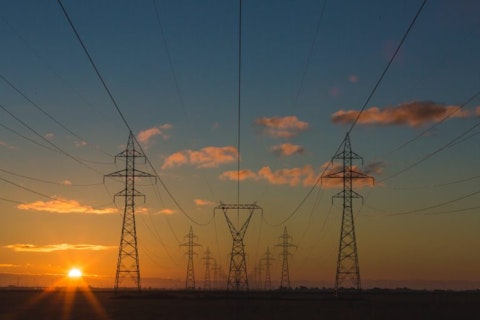Pinnacle West Capital Corporation (NYSE:PNW) Q4 2022 Earnings Call Transcript February 27, 2023
Operator: Good day, everyone, and welcome to the Pinnacle West Capital Corporation 2022 Fourth Quarter Earnings Call. At this time, all participants have been placed on a listen-only mode and the floor will be opened for questions and comments after the presentation. It is now my pleasure to turn the floor over to your host, Amanda Ho. Ma’am, the floor is yours.
Amanda Ho: Thank you, Matt. I would like to thank everyone for participating in this conference call and webcast to review our fourth quarter and full-year 2022 earnings, recent developments and operating performance. Our speakers today will be our Chairman and CEO, Jeff Guldner; and our CFO, Andrew Cooper; Ted Geisler, APS President; Jacob Tetlow, Executive Vice President of Operations; and Jose Esparza, Senior Vice President of Public Policy, are also here with us. First, I need to cover a few details with you. The slides that we are using are available on our Investor Relations website along with our earnings release and related information. Today’s comments and our slides contain forward-looking statements based on current expectations and actual results may differ materially from expectations.
Our annual 2022 Form 10-K was filed this morning. Please refer to that document for forward-looking statements, cautionary language, as well as the risk factors and MD&A sections, which identify risks and uncertainties that could cause actual results to differ materially from those contained in our disclosures. A replay of this call will be available shortly on our website for the next 30 days. It will also be available by telephone through March 6, 2023. Now, I will turn the call over to Jeff.
Jeffrey Guldner: Thanks, Amanda, and thank you all for joining us today. Good morning. In looking back on 2022, it was no doubt one of our most challenging years in recent memory is we faced major financial headwinds and a financial reset resulting from the outcome of our last rate case. I’m going to provide several updates today and share the successes we were able to achieve, despite the challenges we faced. Coming out of last rate case, we laid out a comprehensive plan and strategy and we met or exceeded nearly every target we set for ourselves, including delivering strong service reliability to our customers. We made significant progress in the last year but we’re not done and we look forward to continuing to execute our plan.
Turning now to regulatory, we came out of the last rate case fully committed to improving our regulatory relationships, and we’ve seen progress as a result of our focus in that area. We received constructive decisions for all key items served by the previous bench during 2022, including our financing application last December. We started 2023 with two new commissioners and a new Chair, Commissioner Thompson and Commissioner Meyers joined the bench in January and Commissioner O’Connor was elected Chairman. We’ve already seen constructive actions and decisions by the new bench, including the creation of a docket to examine ways to reduce regulatory lag. We believe that these conversations are important and we look forward to working with the commission on thoughtful solutions.
For our pending rate case, the administrative law judge issued a procedural order in December, outlining the schedule. The first round of staff and intervenor testimony is due in May with the hearing set to commence in early August. We look forward to working with the parties and the commission through the rate case process and in gaining additional regulatory clarity. Our number one goal continues be to be doing what’s right for the people and prosperity of Arizona, which includes working collaboratively with the commission and building a more constructive relationship. Turning to the operation side, I want to start by recognizing our field team’s exceptional execution in 2022, I’m especially proud of our employees for prioritizing safety and ending the year with significantly lower employee injuries.
Three low-energy SIPs and our lowest number of OSHA recordable injuries on record. We had one of the most hazardous and damaging summer storm seasons in recent history, where we saw a record number of poles damaged. And for context we replaced over 800 poles, which is about 500 more than an average summer. In addition, while parts of the southwest region experienced capacity shortages, again in 2022, our careful long-term planning and resource adequacy allowed us to serve our customers reliably. Additionally, we remain engaged in the western wholesale market which allowed us to make off-system sales and to create savings for APS customers. Importantly, those off-system sales directly benefit APS customers by lowering our overall costs, while helping maintain regional grid stability.
And finally, our generation units performed extremely well with our nonnuclear fleet, recording a summertime equivalent availability factor, EAF of 95%, and we achieved a capacity factor of 100.2% at the Palo Verde Generating Station. We recognize the importance of creating customer value and remain focused on improving our customer experience. Our employees are committed to putting customers first and working towards our goal of achieving an industry-leading best-in-class customer experience. As a result of this commitment, we made extraordinary progress on that front in 2022 with APS earning ratings from its customers making it among the most improved utilities in the nation for both residential and business customer satisfaction, measured by J.D. Power.
Compared to 2021, APS achieved quartile gains in every single driver of residential and business customer satisfaction, firmly lifting the company into the second quartile nationally for residential customers, in the first quartile nationally for business customers. Consequently, overall satisfaction is now well above industry benchmarks when compared to the Company’s large investor-owned peers. We also continue to make progress on our resource procurement and clean energy commitment since announcing our goal to reach 100% clean carbon-free energy by 2050, three years ago. We procured over 2,100 megawatts of clean and affordable energy resources. Additionally, as previously discussed, we issued an all-source RFP last year for another 1,000 to 1,500 megawatts of new resources to be in service from 2025 to 2027, and we continue to work through finalizing procurement decisions from that RFP.
These substantial investments are essential resources designed to help us keep pace with Arizona’s tremendous growth. At the same time, electricity capacity markets are tightening across the entire West. Looking forward, our goals for 2023 include, continuously improving our customer communication and engagement; achieving a constructive outcome in our pending rate case; and reliably serving customers through the tremendous growth in our service territory. And I want to once again recognize the near-term headwinds that are created by the unfavorable outcome of our previous rate case and how it will continue to make 2023 challenging. However, we believe in our ability to provide long-term value to both customers and shareholders and we look forward to executing our plan and continuing our proven cost management efforts all against the backdrop of Arizona’s extraordinary economic expansion.
So I want to thank you for your time today and I’m going to turn the call over to Andrew, who will talk about our fourth quarter and full-year 2022 earnings and our forward-looking financial expectations. Andrew?
Andrew Cooper: Thank you, Jeff, and thanks again to everyone for joining us today. This morning we reported our fourth quarter and full-year financial results for 2022 and introduced guidance for 2023. I will cover our results and provide additional details around the financial outlook for 2023 and beyond. As Jeff discussed, we remain in our period of financial reset during the near-term. But right upfront I want to make clear that while we are navigating through challenges brought on by the negative outcome over the last rate case, we have been executing well on our plan and we remain confident in our ability to create renewed growth and deliver strong shareholder returns. For the fourth quarter of 2022, we lost $0.21 per share, down $0.45 compared to fourth quarter 2021.
The unfavorable rate case decision and reduction in net income from no longer deferring the costs related to the Four Corners SCR and Ocotillo modernization project have been the primary driver of lower results all year and that remain the case for the fourth quarter. The quarter also included a $17.1 million impairment charge relating to a Bright Canyon energy equity investment. This was a legacy investment by Bright Canyon for a minority stake in a wind farm. In the fourth quarter, we determined that impairment of the investment was appropriate due to ongoing disputes on transmission cost allocation and a lack of a probable favorable outcome. Other negative impacts included lower LFCR revenues, higher O&M and higher interest expense. Favorable weather and customer and sales growth were partial offsets to the negative drivers in the fourth quarter.
For our full year results for 2022, we earned $4.26 per share, down from $5.47 per share in 2021. We ended the year in line with our updated full year guidance. As noted earlier, the negative rate case outcome drove a financial reset and is the primary driver for the lower year-over-year results. The Bright Canyon impairment charge, higher O&M and higher interest expense were other negative drivers for lower year-over-year results. The Bright Canyon impairment charge, higher O&M and higher interest expense were other negative drivers for lower year-over-year results. For the year, we saw beneficial weather as well as customer and sales growth that partially offset the negative drivers. Turning to customer growth the fourth quarter remained in-line with our guidance at 2.1%, which was also the customer growth rate for the full-year.
Arizona continues to be a popular destination for relocation and have the fifth highest population growth in 2022, according to recent data from U.S. Census Bureau. Arizona has continued to show strong employment growth, including an emerging areas of economic diversification with manufacturing employment, for example, growing at 6.2% to 2022 as compared to a U.S. rate of 3.8%. We also continue to experience strong weather health growth. Sales increased 1.2% in the fourth quarter relative to the prior year and for the full year 2022, our weather-normalized sales growth was 2.4% in line with our upwardly revised guidance range. This was anchored by strong C&I growth of 4.6% over 2021, as the benefits of Arizona is increasingly diversified economy realized.
In fact, Phoenix Metro was recently named a top three industrial market to watch in 2023 according to a JLL tenant demand study that evaluated 60 U.S. markets. Moving on to our financial outlook. Our 2023 earnings guidance range is $3.95 to $4.15 per share. Although this is a decline from 2022 actual results, the range is comparable to our weather-normalized 2022 guidance range of $3.90 to $4.10 per share. We forecast steady customer growth and robust sales growth ahead in 2023. Headwinds for 2023 include higher benefit expense, interest expense and plant D&A. We continue to target declining O&M per megawatt hour and believe our proven track record of cost management and lean initiatives will help us successfully navigate through this inflationary period.
We continue to have a strong focus on O&M and look for opportunities to create efficiencies, reduce risk and keep our costs low to maintain affordable rates for our customers. Looking at our forecasted customer growth, we expect it to remain strong and are maintaining the 1.5% to 2.5% guidance range for 2023. On sales growth we expect continued strength particularly in the C&I segments as economic diversification takes hold in areas such as semiconductor hubs, other large manufacturing and distribution. In fact, TSMC recently announced plans to build a second fab of the North Phoenix location increasing its original $12 billion investment to $40 billion. TSMC estimates site will employ 4,500 permanent jobs and increase from the earlier projection of 2,000.
In addition, Procter & Gamble, also announced plans for $500 million investments in the manufacturing facility, creating 500 new jobs. Anchored by examples like these, we are expecting our weather-normalized sales growth range to be 3.5% to 5.5% for 2023. Turning to pension. As a reminder, our pension is 106% funded with no expectation for contributions needed in the near-term. We remain committed to the long-term benefits of our liability driven investment strategy and the reduced volatility of a fixed-income weighted portfolio. Nevertheless, we are expecting a headwind in 2023, primarily resulting from the net effect of higher discount rates. Higher benefit expense in 2023 has also impacted by negative 2022 investment returns and is partially offset by the impact of higher expected returns on assets in 2023.
All-in we expect benefit expense to be $0.33 headwind for 2023 as compared to 2022. However, we continue to evaluate options for regulatory recovery of higher benefit expense. Turning to interest expense as the Federal Reserve continues to raise interest rates, try to combat inflation. We are closely monitoring our financing needs. I would highlight that we do not have any maturities until mid-2024, that we do expect higher interest expense year-over-year. We’ve also updated our capital plan to $5.3 billion from 2023 to 2025 with rate base growth at an average annual growth rate of 5% to 7%. Importantly, the increase in CapEx is independent of any rate case outcome and is directly related to loan growth and the needed investments we are making in more resilient infrastructure.
This update is need to simply to keep up with that growth and reliably serve customers. We have also updated our financing plan to meet the demands of our updated capital plan. We are continuing to defer any equity issuance and so resolution of the current rate case and remain focused on achieving a constructive regulatory outcome. The rest of our financial outlook remains consistent. Our outlook includes long-term earnings growth of 5% to 7% of the midpoint of our weather-normalized 2022 guidance range. We have a track record of dividend growth and the Board recently raised our quarterly dividend to $0.865 per share. While our current payout ratio is higher than our target, we believe our plan will allow us to achieve our long-term dividend payout ratio of 65% to 75% in the future, recognizing that all future dividends are subject to approval by our Board.
We have a path forward that is centered around our long-term track-record of constructive rate case outcomes, a robust service territory growth, continued balance sheet strength and cost discipline and a focused management team that is taking action. We look-forward to building on the great work we were able to accomplish in 2022 and executing on this plan in 2023. This concludes our prepared remarks. I’ll now turn the call back over to the operator for questions.
See also 15 Countries with the Largest Uranium Reserves in the World and 20 Biggest Nonalcoholic Beverage Companies in the US.
Q&A Session
Follow Pinnacle West Capital Corp (NYSE:PNW)
Follow Pinnacle West Capital Corp (NYSE:PNW)
Operator: Certainly. At this time we’ll be conducting a question-and-answer session. Your first question is coming from Julien Dumoulin-Smith from Bank of America. Your line is live.
Dariusz Lozny: Hi, good morning. This is Dariusz on for Julian. Just starting off, I wanted to touch on the financing plan a little bit, recognizing that you won’t need equity or won’t be issuing equity until after the current rate case. Can you just maybe help us think about, how you’re looking at future equity need beyond the pendency of the rate case in 2024 and 2025? In particular, in the context of the higher capital plan?
Andrew Cooper: Sure, Dariusz. It’s Andrew. As you noted, we do have an equity need in the plan there, that $400 million to $500 million of equity in 2024. And that’s really set up to make sure that the APS equity layer is appropriately capitalized coming out of the rate case given some of the debt that weren’t for APS in the near term. Any future equity needs will really be dependent on the capital plan that we developed after the rate case concludes. As I mentioned earlier, the capital that we’ve added into the plan here is really dependent on load growth and serving the service territories it expands. Once we get through the rate case and think about, for example, our clean capital spend, that will be an area where as we with a constructive outcome consider a different ratio of self-build versus PPA assets.
We will look at the financing plan at that point to make a determination. We’ll also be looking for feedback from the rating agencies on our credit metrics at the conclusion of the rate case to figure out the right capital plan for the years beyond 2024. But as of now, the need for 2024, that $400 million to $500 million post the rate case is intact.
Dariusz Lozny: Excellent. Thank you. And maybe if I can touch on the robust loan growth forecast and you guys said out there and then you update this morning. Can you maybe just discuss a little bit about what your level of visibility is on the contribution to that lower growth? Other than TSMC I know you mentioned a couple of other large customers coming online over this period. And also within the context of your 5% to 7% EPS CAGR, can you maybe discuss how much if any delays could be absorbed to the largest TSMC project that would still allow you to maintain that 5% to 7% within this forecast period?
Andrew Cooper: Sure, Dariusz. So the forecast is driven by a diversified group of manufacturing, data center customers and some of the overall C&I growth that we’re seeing in the service territory. It’s a pretty different economic story than it’s been in the past as far as the factors contributing to growth here. We’re not really depending on the broader macroeconomic story as much as specifically identified customers, which include TSMC, and it’s a considerable part of that. The 2% to 4% of the 3.5% to 5.5%, that is from the large customers, TSMC is a considerable part of that, but there is data center customers and other manufacturing there as well. So it’s pretty diversified on that front. The 5% to 7% earnings growth rate is through 2026, and that’s pretty much coterminous.
The sales growth rate — the long-term sale growth rate that we have here is through 2025, but roughly similar trends through that forecast period. As you’ve seen even in 2022, that sales growth is certainly helping us to mitigate the inflation and some of the O&M pressure that we’re seeing. And we’ll continue to work both those cost levers and keep a close eye on the macroeconomic environment and the specific customers as well as we go through the forecast period.
Dariusz Lozny: Okay. Great. Well, thank you for that detail. Looking-forward to catching-up later in the week.
Jeffrey Guldner: Thanks, Dariusz.
Operator: Thank you. Your next question is coming from Shar Pourreza from Guggenheim. Your line is live.






